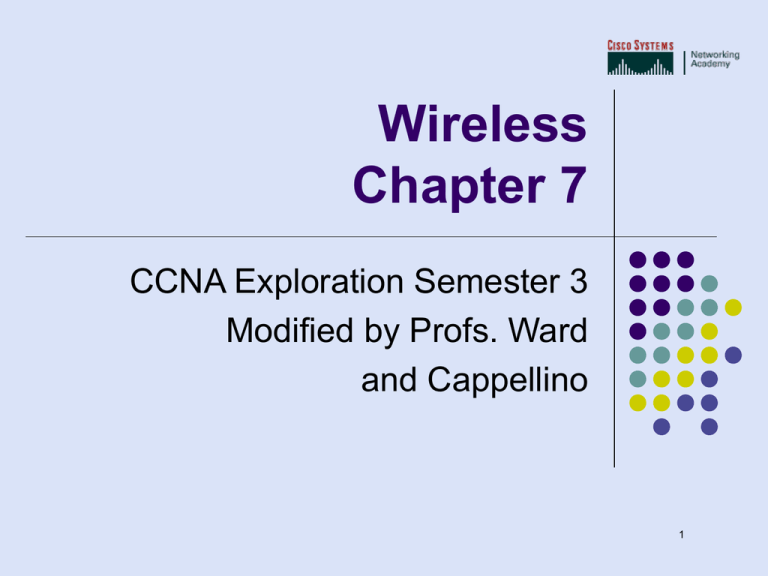Wireless Review
advertisement

Wireless Chapter 7 CCNA Exploration Semester 3 Modified by Profs. Ward and Cappellino 1 Topics Components and basic operation of wireless LANs Basic WLAN security Configure and verify basic wireless LAN access Troubleshoot wireless client access 2 Semester 3 LAN Design Basic Switch Concepts Wireless- Chp 7 VLANs STP VTP Inter-VLAN routing 3 Wireless Review Wireless was covered in CSN208, therefore, only new material will be presented here Must have understanding of entire chapter Please see me, the curriculum or the CSN208 text with questions Review- what is an AP? Review- what is a wireless NIC? 4 Wireless router Acts as: Router for use in ___________________ Ethernet ______________ and wireless __________________________ Configuration on both the ____________________ is necessary Parameters: Mode refers to the 802.11a, b, g, or n Configure SSID – what is the SSID? Select channel within 2.4GHz band _________________________ should be set to use _____________________________5 Channel Graph 6 Different 802.11 Wireless Topologies… Ad Hoc Basis Service Set (BSS) Extended Service Set (ESS) More to come on each of these… 7 ______________ topology WLAN operating with _________________ _________________ Negotiate parameters Independent basic service set Area covered is basic service area (_____) 8 __________________ topology _________________ Access point _________ ____________________ ___________________ for clients Uses _________ mode Area covered is basic service area (_______). 9 ________________ topology _____________________ ___________________ Access point manages parameters for clients __________ mode used Area covered is extended service area (_____). A common distribution system allows multiple access points in an ESS to appear to be a single BSS. 10 Beacon and probe Discovering a WLAN and connecting to it involves the following components: ________ - _________ used by the WLAN networks to _____________________ Access point may send out a beacon at regular intervals for ________________________ _________ - Frames _____________________ ________________________ Client sends a probe specifying the _____________ supported. ________________________ Client can send probe with no SSID to look for any network. Access point may be configured to respond, or not. Components continued on next slide… 11 Authentication Components cont… ______________ One of three ___________ __________________________ __________________________ ____________________________ 802.11 had two authentication mechanisms. ________ (Open Authentication) does not give privacy Wired Equivalency Protection (__________) Newer and more secure authentication method: Wi-Fi Protected Access (_________) Components continued on next slide… 12 Association Components cont… _______________ - The process for _________ _________________________________________ __________________________ Request from client and response. Finalizes __________________ Finalizes ____________________ ________________________ ____________ the access point MAC address (_______) Access point maps a logical port known as the association identifier (AID) to the WLAN client. Traffic can then flow between the two devices 13 Planning the WLAN Implement a _____________________ prior to construction of a WLAN RF is a shared medium so the ______________ ______________________ for RF Place AP: Above obstructions/ at least 3 feet from metal obstructions Vertically and high up/in the ceiling. In locations where users will work. Work out the coverage for each AP. ___________________________ 14 Wireless Security/Protocol review These topics are also a review of the same material covered in CSN208 Review- what are some security threats? Review- what are some disruptive attacks that could affect a business? Review- what are some Wireless protocols we have studied? Review- what type of encryption does Wireless use? 15 Controlling Access to the Wireless LAN Possibilities for controlling access: ___________________ - __________________________ from access points __________ considered a ___________________ since SSID can still be easily discovered ____________________ - Tables are manually constructed on the access point to _________________ __________________________________ _____________ considered a way to secure a WLAN since ______________________________ WLAN _____________________ - ________________ ______________________________ of the AP 16 Configuring Access Point Remember: To configure and test incrementally Most access points have been _______________________ ______________________ with the default settings ________________________________! 17 Basic Wireless Settings _______________ – Lets you choose the right mode for your devices. B, G, N, mixed or BG mixed. You can disable wireless operation. __________________ – should be changed from the default. ______________________________ on the network. _____________ can be enabled or disabled. 18 More Basic Wireless Settings Radio Band – For best performance, keep the __________. For Wireless-N devices only, select Wide 40MHz Channel. If you selected Wide for the Radio Band, Select a channel from the drop-down menu of the “Wide Channel” parameter For Wireless-G and Wireless-B only, select Standard - 20MHz Channel. If you selected Standard for the Radio Band, Select a channel from the drop-down menu of the “Standard Channel” parameter See summary graphic next slide… 19 Summary of Linksys Settings 20 Configure Security on the Linksys Security mode Mode parameters RADIUS Server IP address RADIUS Server Port Encryption Pre-shared Key Key Renewal 21 Configure Security on the Linksys cont… Choose _____________________ if all client devices are able to use it. If some older devices do not support WPA2 then choose the best security mode that is supported by all devices. Encryption – _______________________. Use AES with WPA2. 22 Configure the client After the access point has been configured, you need to ___________________________________ to allow it to connect to the wireless network. First, scan for available WLAN’s and SSID’s If a WLAN does not show up on an auto scan- what could be the problem? Proceed manually Add a wireless network Enter the SSID Choose the authentication method Choose the encryption method Enter the network key. Now confirm connectivity with the AP using ping 23 Troubleshooting _____________ Generally start with the ___________________ __________________ the TCP/IP stack… Check the ________________________ then Update __________________ 24 Troubleshooting – no connectivity Check that the PC has an ___________ Try connecting the PC to the wired network and ping a known address Try a ___________________. Reload drivers as necessary. Check the ______________________ settings on the client. Do they match the access point? 25 Troubleshooting – poor connection Check __________________ Check the ______________ on the client. Check for devices that might be causing ______________ (cordless phone, microwave oven etc). 26 Troubleshooting – additional questions Are all devices in place? Are they all powered on? Are wired links working correctly? Is there a neighboring access point using an overlapping wave band? Are access points badly placed? 27







